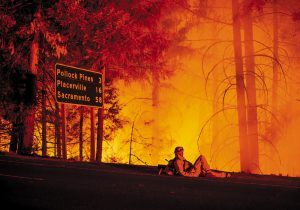William Finnegan in the New York Review of Books:
 On the northwestern edge of Los Angeles, where I grew up, the wildfires came in late summer. We lived in a new subdivision, and behind our house were the hills, golden and parched. We would hose down the wood-shingled roof as fire crews bivouacked in our street. Our neighborhood never burned, but others did. In the Bel Air fire of 1961, nearly five hundred homes burned, including those of Burt Lancaster and Zsa Zsa Gabor. We were all living in the “wildland-urban interface,” as it is now called. More subdivisions were built, farther out, and for my family the wildfire threat receded.
On the northwestern edge of Los Angeles, where I grew up, the wildfires came in late summer. We lived in a new subdivision, and behind our house were the hills, golden and parched. We would hose down the wood-shingled roof as fire crews bivouacked in our street. Our neighborhood never burned, but others did. In the Bel Air fire of 1961, nearly five hundred homes burned, including those of Burt Lancaster and Zsa Zsa Gabor. We were all living in the “wildland-urban interface,” as it is now called. More subdivisions were built, farther out, and for my family the wildfire threat receded.
Tens of millions of Americans live in that fire-prone interface today—the number keeps growing—and the wildfire threat has become, for a number of political and environmental reasons, immensely more serious. In LA, fire season now stretches into December, as grimly demonstrated by the wildfires that burned across Southern California in late 2017, including the Thomas Fire, in Santa Barbara County, the largest in the state’s modern history. Nationally, fire seasons are on average seventy-eight days longer than they were in 1970, according to the US Forest Service. Wildfires burn twice as many acres as they did thirty years ago. “Of the ten years with the largest amount of acreage burned in the United States,” Edward Struzik notes in Firestorm: How Wildfire Will Shape Our Future, nine have occurred since 2000. Individual fires, meanwhile, are bigger, hotter, faster, more expensive and difficult to fight, and more destructive than ever before. We have entered the era of the megafire—defined as a wildfire that burns more than 100,000 acres.
More here.
